


PITTSBURGH’S ALTERNATIVE FOR NEWS, ARTS + ENTERTAINMENT SINCE 1991







PITTSBURGH’S ALTERNATIVE FOR NEWS, ARTS + ENTERTAINMENT SINCE 1991



From art and design to food, sauna, and song, the Steel City offers plenty of ways to channel a northern mood
BY: AAKANKSHA AGARWAL

As Pittsburghers, we’ve all been there.

You’re in your car at the bottom of a steep hill covered in slick ice and snow. You shift into gear, start moving upward, and you think you just might make it.
Then you feel the tires spin out. You gun the gas, you try to maneuver, but eventually you face it: you’re just not getting up this hill. You have to find another way.
Thankfully, in Pittsburgh, with its winding roads and seemingly endless alternate routes, there’s always another way.
Pittsburgh City Paper has found itself facing that steep climb. Like many newspapers — especially the free alt-weekies across the nation — for a while now, we’ve been battling hard times. And it’s not because we lack the drive. We’re facing rising costs and less revenue, but also, misinformation, hostility towards media, a rough economy, and loss of talent to more stable industries.
But we’ve kept on. For 34 years, to be exact. And I’m here to say, despite the challenges, we’re going to keep on keeping on.





Executive Editor ALI TRACHTA
Director of Operations KEVIN SHEPHERD
Director of Advertising NATE NILES
A&E Editor AMANDA WALTZ
News Editor COLIN WILLIAMS
Sta Writer RACHEL WILKINSON
Photographer MARS JOHNSON
Audience Engagement Specialist STACY ROUNDS
Editorial Designer JEFF SCHRECKENGOST
Graphic Designer SAM SCHAFFER
Senior Advertising Representative CODY WALTERS
Advertising Representatives
Let me make this absolutely crystal-polished-with-Windex clear: Pittsburgh City Paper isn’t going anywhere. Every single day, we’re going to keep bringing you the alternative take on news and underthe-radar culture you’ve enjoyed from this “woke Commie rag” for decades.
But the package it comes in is going to look a little different, at least for a time. In order to rebuild to a more solid place, we’ve made the difficult decision to drastically reduce the rate at which we print. For now. It breaks my heart a little, but this is the last weekly version of the print paper you’re going to see for a while.
But print isn’t dead, and neither are we.


Instead of a weekly digest, City Paper will now bring you four super-issues per year, starting this December. In those editions, which will function as your “Bible” for the season, you’ll find an essential collection of event listings, in-depth news coverage, and off-the-wall arts and entertainment stories you’re used to seeing from us year-round. Plus, contained within will be your favorite greatest hits, including our People of the Year feature, election guide, and of course, the pièce de City Paper resistance: our annual Best of PGH issue. And you’d better believe we still intend to throw our famous Best of PGH party along with it.
BRAD QUATCHAK, HAREE LIM
Junior Advertising Representative
T’YANNA MCINTYRE
Marketing Coordinator CANDACE DAVIS
Digital Coordinator DEBI JOHNSON
Circulation Manager JEFF ENGBARTH
Contributors KAHMEELA ADAMS-FRIEDSON, AAKANKSHA AGARWAL, REGE BEHE, LYNN CULLEN, MATT PETRAS, DAVID S. ROTENSTEIN, JORDAN SNOWDEN
National Advertising Representative VMG ADVERTISING
1.888.278.9866 OR
Publisher CARS HOLDING, INC GENERAL POLICIES: Contents
2025 by CARS Holding, Inc. All rights reserved. No part of this publication may be reproduced without written permission of the publisher. The opinions expressed in Pittsburgh City


In the meantime, check out pghcitypaper.com every day to see new content: of-the-moment news, under-the-radar arts and culture, photo essays, your favorite columns, and plenty more.
All we ask, dear readers, is this: please bear with us. We are setting the stage to rebuild, and we have every intention to come back bigger, better, and stronger … but just as delightfully weird and wacky as we’ve always been.
Hopefully it’s all downhill from here.
With love,
Ali Trachta Executive Editor, Pittsburgh City Paper

Holding, Inc. and is available free of charge at select distribution locations. One copy per reader; copies of past issues may be purchased for $3.00 each, payable in advance to Pittsburgh City Paper












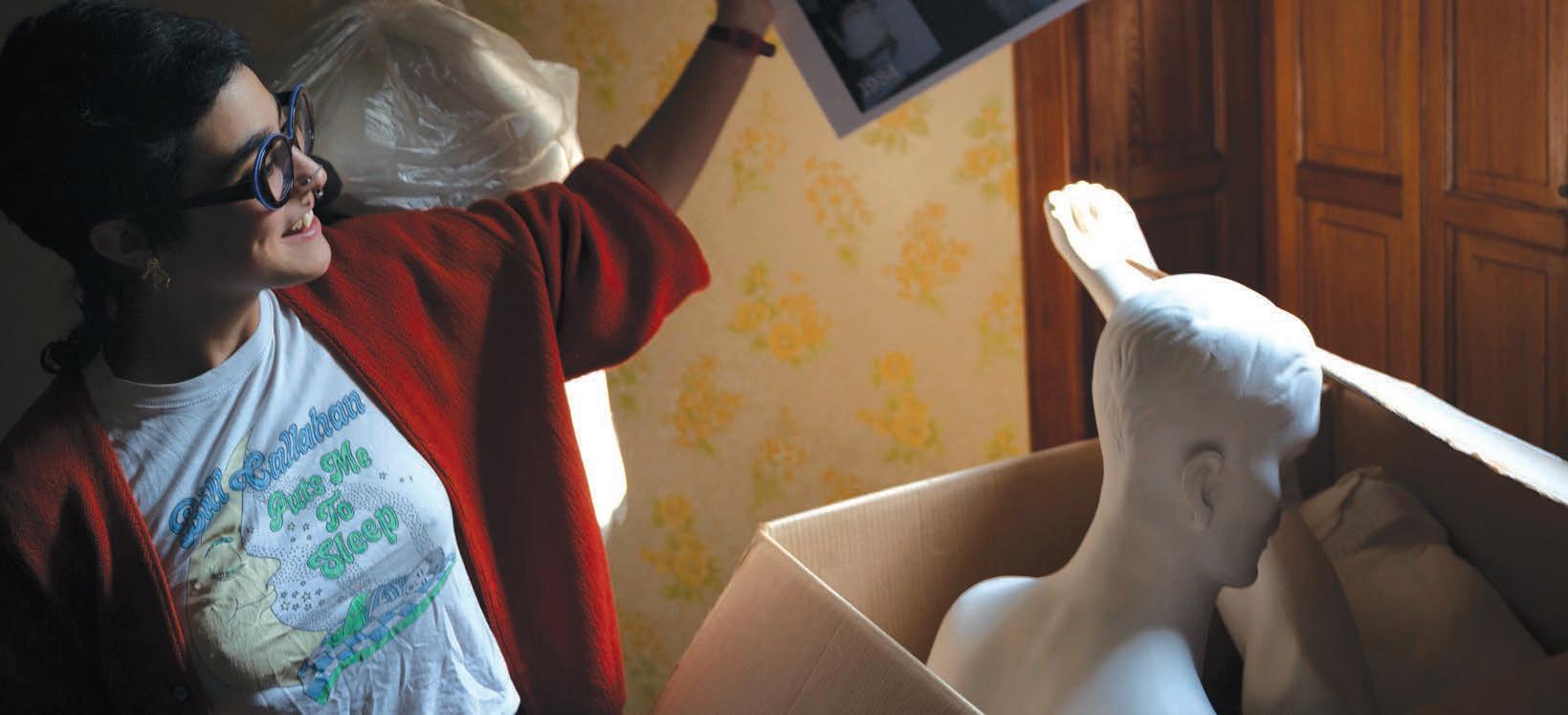
A new tour will bring visitors to Clayton’s upper floors ahead of a multimillion-dollar preservation effort
BY: CP STAFF // INFO@PGHCITYPAPER.COM
Pittsburgh’s Gilded Age history is everywhere, from Downtown’s ornate towers to the museums, libraries, and parks bearing the names of deceased industrialists. However, many of these same industrialists specifically had their Point Breeze homes demolished — the Westinghouse and Mellon estates are now public parks, and the former Heinz estate is now a block of housing behind the walls that once surrounded the Heinzes’ gardens. Not so with the estate of Henry Clay Frick. Clayton, the ancestral Frick home, stands as an enduring reminder of industrial wealth, good
taste, and stark income inequality. However, visitors to Clayton won’t have seen fully half of the mansion. That will change in November, when the Frick Pittsburgh will, for the first time, open Clayton’s third and fourth floors to curious visitors as part of a multi-phase $10 million preservation effort.
It’s largely thanks to Helen Clay Frick, who, per Frick Pittsburgh staff, “adored” her childhood home, that the mansion still stands. “This house was her home. It was her baby,” Frick Pittsburgh collections and exhibitions assistant Bella Hanley told media
during a recent sneak preview of the forthcoming tour. “I think she’d be really glad to see that we are still making the effort to take care of it and to make sure it lasts another 150 years.”
If nature had its way, the house might not still be here. Clayton has been victim to the forces that plague countless other Pittsburgh homes: water damage, lack of modern HVAC, and deteriorating masonry have all posed challenges. The tour of the upper floors is partly a bid to change that with help from visitors. While the exterior undergoes a loving restoration, Frick Pittsburgh staff has
worked to stabilize the interior ahead of a fuller restoration.
Much like Henry Clay Frick himself, Clayton stands as a flawed reminder of Pittsburgh’s past, present, and future. As we did following the award-winning Gilded, Not Golden tour , Pittsburgh City Paper staff sat down following the tour to discuss what we saw — and what visitors can expect when public tours begin later this fall. The following conversation has been edited for length and clarity.
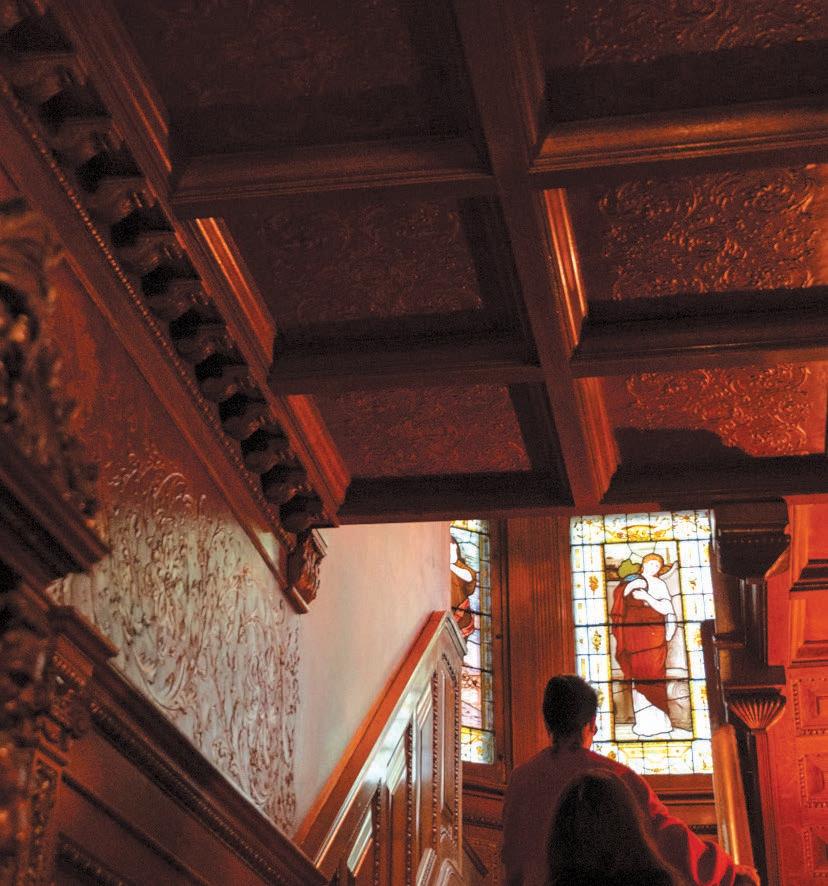
Colin Williams, news editor: I thought the upper floors revealed a lot about the family, but they also revealed a lot about the house.
Rachel Wilkinson, staff writer: That was the first thing I wrote down — and I felt like you were feeling this way, too, Colin — was they were listing off all the various home proects they have to complete for preservation, and it ust sounded like an old Pittsburgh house. I heard paint stripping, box gutters, water damage, creating access panels to do further repairs. nd I was like, I empathi e, and feel a bit triggered, honestly. hereas the downstairs definitely feels more like a museum, almost like a bug fro en in amber in 1 , this did feel like an old Pittsburgh house that still looks like an old Pittsburgh house, which is sort of surreal to think about because it’s the Fricks.
Mars Johnson, staff photographer: I was curious what their plan was, if they’re going to try to completely restore it, or if they’re ust kind of doing preventative measures so it doesn’t get worse than it is. It sounds like their budget is also not cra y.
Colin: One thing I think is really remarkable about historic preservation — and even Pittsburgh homeownership is that you’re ust constantly having to fight the elements and fight the passage of time. I also thought it was really remarkable that, even for a family that was this wealthy, that had this much power, that they still ust made awful renovation choices in the ’ 0s. ne thing that I was left thinking is that I hope they keep at least one room not restored to the 1 th century because it really does speak to the history of the house, and also the history of architecture in merica.
Colin: s we all know, Frick was not a big fan of organi ed labor To that point, as well, it’s hard to kind of imagine that level of dependency on other people. It also really speaks to, not only was there a lot of income ine uality in merica at the time, but there were ust so many people cheek by owl that you could pretty easily afford to have five plus people in your employ. These days, you don’t really hear about butlers and maids and governesses and stuff in the same way. ut there was an entire business being run out of their home, where they had a school and a transit system and maintenance staff.
Rachel: I think on the last tour, they said they had someone whose ob it was ust to beat the soot out of those big velvet curtains.
Colin: The water damage in particular was pretty extensive, right? There were some rooms that were pretty thoroughly destroyed, and clearly there’s a lot of work to be done to remediate that stuff. hen it comes to things like the box gutters, I don’t envy them having to deal with that. ut I also think it speaks to the fact that this wasn’t touched for so long.
Rachel: Not only did Helen Frick live out the end of her life there in the course of Clayton being a museum, but the staff used it to take breaks and store Christmas decorations!
Colin: It was interesting how much the upper floors were function over form compared to the lower two floors.
Rachel: I really liked the chauffeur’s room in that respect because I feel like with Gilded, Not Golden, they went to these great lengths to incorporate the stories of people who were not ust the Fricks, not only people and staff that came through the house, but the life of working Pittsburghers who worked in Frick’s mills. I think the intention is to keep some of that and not ust completely go back in time to whatever it was when they first built the mansion, but I like incorporating the life of the staff that were also in the house.
Mars: They touch on it pretty immediately in the regular Clayton tour, how much the staff is factored into the living quarters and the call buttons and and everything. I don’t know if you guys saw it on the first tour, but they had a painting that Frick put up that was basically taunting the workers as they came in. t the top of the stairs, there was a painting of a donkey that was basically calling them lesser than. I forget exactly what the message was, but it was basically ‘you’re down here, and we’re up here, and don’t try to get better pay.’
Mars: It’s a weird dynamic to have people that aren’t your family around ust so that you have clean laundry all the time.
Colin: s far as the rooms, what stuck with you the most?
Mars: [Referring to a pair of decaying shoes found in a crawlspace] The room where they found the shoes, that was a really cool room. I also liked the room that has the halfpainted, half floral wallpaper and a bunch of archival photos.
Colin: Yeah, the playroom with the big bay window — that was such an oddly shaped room. The way they built additions to the house, it felt very ramshackle. hen I’ve been in other mansions or palaces, there’s a real logic to the layout — when you think about Versailles or something, it’s all very symmetrical and orderly. This house was kind of hodge podgy.
Rachel: The schoolroom in the attic with all the trunks in it was really cool.
Colin: That stuck with me the most because, for some reason, it made me think of The Secret Garden


I pictured these kids spending all day in this house with so many little hidey-holes, and I could just imagine being bored during your lessons, and you’re up in this hot attic, but there are all these little nooks and crannies you can kind of disappear into. It gave me an image of kids leading their governess on a chase through the upper floors.
Rachel: Like, “Get back here! It’s time for your German lessons!” Classic Pittsburgh is that her only fellow pupil was Virginia Frew. Of course, it’s the Frews who have a street named after them in Oakland near Carnegie Mellon. All the names are really from 20 families and recur over and over and over and over again.
Colin: You’ve got to think, for all that they were this really cosmopolitan family and were traveling all over the place, that their day-to-day world was pretty small, especially for the kids. They’re not being socialized in a public school with hundreds of other people. They’re in a room with one other person who’s also as blueblooded as they come, just learning about the world literally from on high, four stories up above everybody else.
Rachel: One thing we know about Helen Frick is she was completely devoted to curating a certain image of her family and preserving the less unsavory parts of its legacy. So I love this question of, how would she feel about opening up this part of the

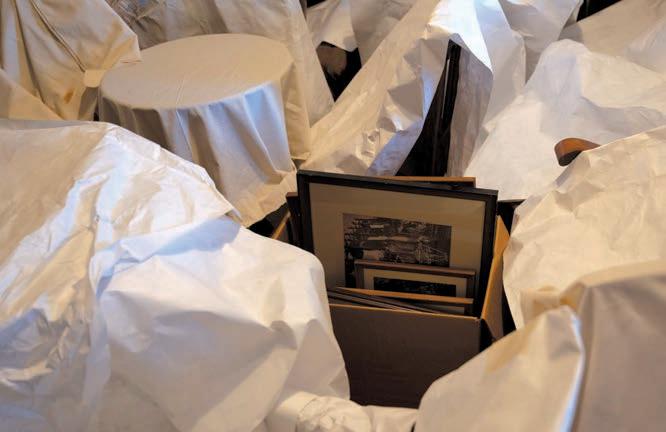
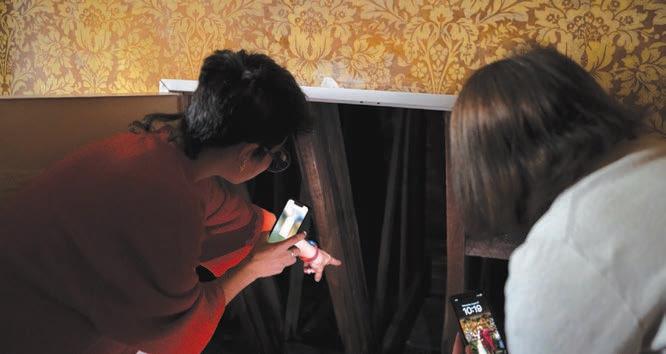
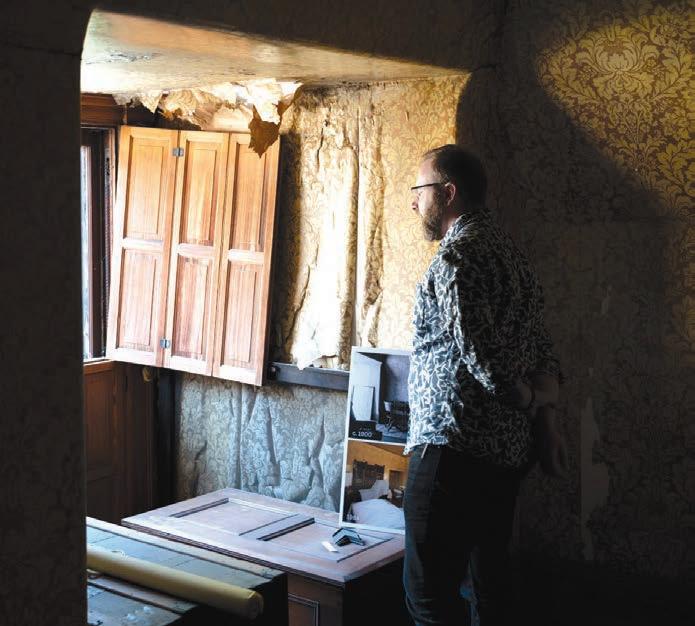
mansion? I feel like there’s this very concrete divide between the museum as we know it and the behind-thescenes of the museum that will now become part of the museum. If you want the full sweep from the Gilded Age in 1892 to the nadir of Pittsburgh’s steel industry in 1980, maybe this is the best way to do it.
Mars: This might not be totally accurate, but I feel like there was a lot more sentimental value for people back then wanting to continue to stay in their family’s houses.
Rachel: I wonder why she did love it so much, because that’s repeated a lot: “she adored the house; she loved the house.”
Colin: One of the things that history is clear about is when they built that house in New York City that’s now the Frick Collection, the house was kind of built to be a museum. I can’t remember if it was Helen or if it was Henry who
described it as being like a mausoleum. The house in New York is huge. It’s stone. It’s very cold. There’s marble everywhere. It’s very, very different from Clayton, which is warm wood, cozy. There are a lot of really small rooms in Clayton for a mansion.
I actually found myself wondering if Helen felt any pressure from the fact that a lot of other wealthy families in Pittsburgh actually demolished their estates. Helen really fought for a private space to remain. I don’t know that she wanted the public to see their sitz baths or know details about the assassination attempt, but it was clearly a deliberate choice to preserve this that other people didn’t make.
Rachel: It makes me wonder — with her father being probably the greatest villain of Pittsburgh history, maybe it was worth it to try to humanize the family as much as possible, and maybe the house did that in a way that other things couldn’t? •

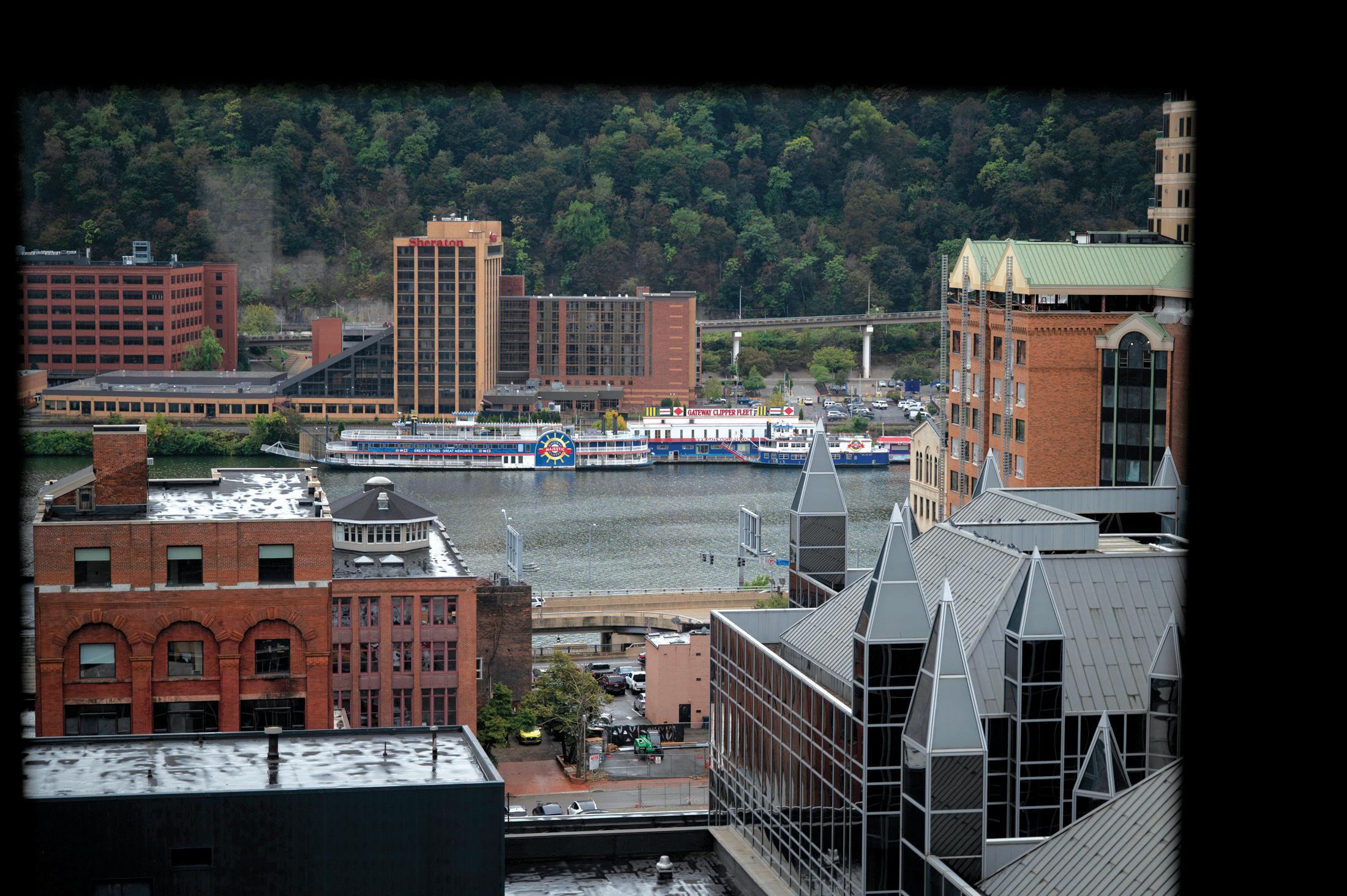
Pittsburgh’s riverfronts once served as a bustling transport hub and seedy entertainment district
BY: DAVID S. ROTENSTEIN
ittsburgh was once a seedy river city. The three rivers once floated an armada of criminal activities: bootlegging, gambling, prostitution, and theft. Fortunately, the only pirates in the city’s history were its sports teams (though some today might say that the Buccos’ recent performance is criminal). The rivers were like the rest of the city at the time — vice operated openly and became part of Pittsburgh history and lore.
While other cities leverage their seedy stories to attract tourists and to engage riverside spaces, Pittsburgh tends to overlook the opportunities to drop anchor in its criminal history and fish for stories to sell the city.
“The simple view is that, without these rivers and without these river valleys, there is no Pittsburgh,” tells Pittsburgh City Paper Rivers of Steel historian Ron Baraff. “Back in steamboats and on the sternwheelers and
using the Mon Wharf, for example, a docked sternwheeler … becomes a river-based playhouse. And I mean that in all sense of the words. But also for gambling and drinking in restaurants all the way up through where we are now.”
Riverlife executive director, Matthew Galluzzo, believes some organizations do a good job describing how Pittsburgh's rivers fit into the city's steel, glass, and shipbuilding history. But he thinks the city could do a better job telling a more complete story in ways that are educational and fun.
“Could we do a more transparent or ubiquitous approach to that?” Galluzzo wonders. “Could we have more interpretive signage and [could] every region … reinforce their history in meaningful ways?”
But when it comes to how Pittsburgh leverages its vast
riverfront spaces for entertainment — there are about 5 miles of riverbank just inside the city alone — he thinks the city might be adrift and could do things better.
of their self-propelled cousins.
“The smaller ones look like oldtime packets with their smoke stacks knocked off, and the larger ones like two story Pittsburgh apartment
“THERE ISN’T A FORM OF DEPRAVITY THAT HASN’T BEEN PUT ON A DIVIDENDBEARING BASIS IN PITTSBURGH.”
ot too long ago, creative entrepreneurs found numerous ways to entertain and generate profit while floating on docked boats and barges. Those pleasure palaces drew upon a pivotal point in Pittsburgh history when, in 1 1, illiam Chapman launched the Floating Theater, the nation’s first showboat, down the hio iver.
It didn’t take long for copycats and other innovators to create a small fleet of showboats moving from landing to landing on what were then called the estern ivers, the ississippi and hio rivers and their tributaries.
howboats plied the three rivers for much of the 1 th and 20 th centuries. Though they freuently stopped at onongahela iver coal mining towns early on, by the mid-20 th century, most showboats began or ended their annual seasons here in Pittsburgh.
“The complete showboat circuit, start ed each year at Pittsburgh or even up the onongahela, and end ed at ew rleans,” wrote historian Philip raham in his 1 51 book, Showboats: The History of an American Institution
The ateway Clipper fleet’s e cursion boats are replicas of earlier steamboats that once carried mail and people from New Orleans up the ississippi and hio rivers. Though many of those early sternwheelers featured entertainment during trips, showboats were a special breed. They copied some of the architecture
houses,” raham wrote. ome of the larger boats could host more than 900 people at a time.
“A showboat would be like ... a theater built on a barge, retired riverboat captain onald anders tells City Paper. ou go inside, and there would be the stage, and there would be an auditorium.”
howboats were towed from landing to landing, where their arrival would be announced by a calliope playing “ ere Comes the howboat.” People on the banks of the hio, onongahela, and llegheny rivers could hear the tune for miles. They would make their way down to the on harf where they could see a play, vaudeville act, or band concert.
everal notable showboat owners hailed from or called Pittsburgh home. alph merson aches was a natural-born entertainment huckster. The son of a popular railroad conductor, aches spent the first years of his life on the orth ide. fter his mother died, ames aches remarried and moved his family to etart Township in eigs County, hio. There, alph got his first taste of hio iver life. s a teenager in the mid 1 0s, he ran away from home to sign onto a riverboat.
y 1 , aches was working on Price’s ater ueen showboat, which made regular trips to Pittsburgh. ithin a decade, aches had worked his way up from distributing show flyers to managing the ater ueen and, in 1 0 , buying his own showboat, merson’s rand Floating Palace. y that time, he was calling himself Captain alph aldo
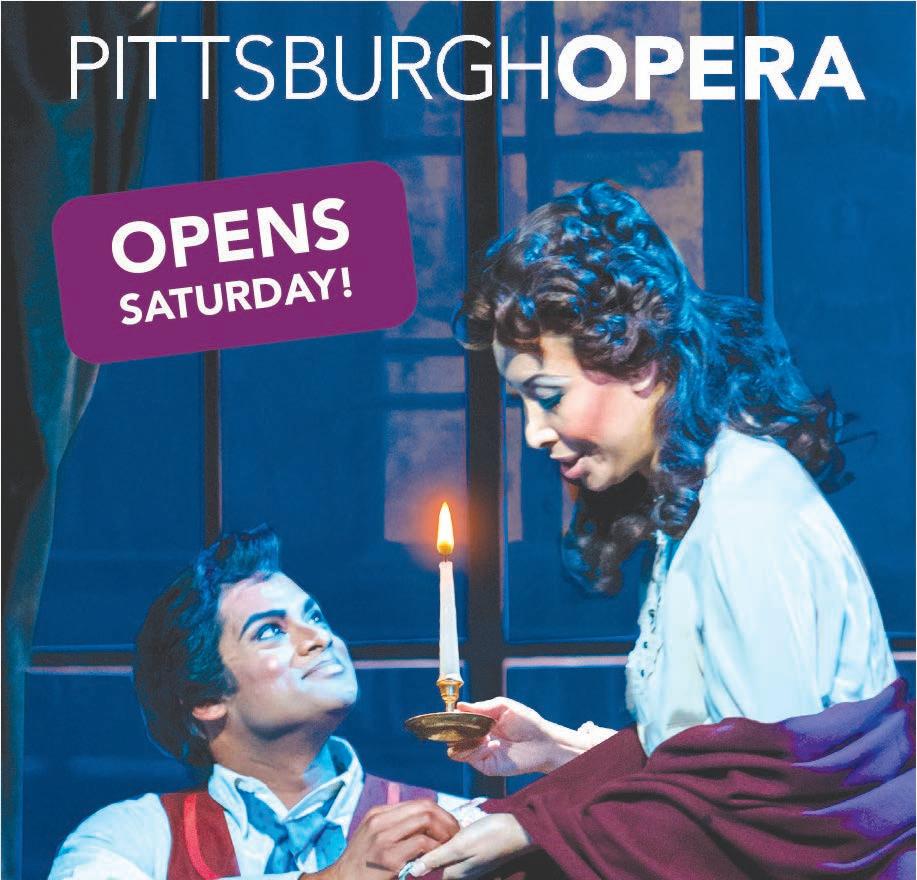
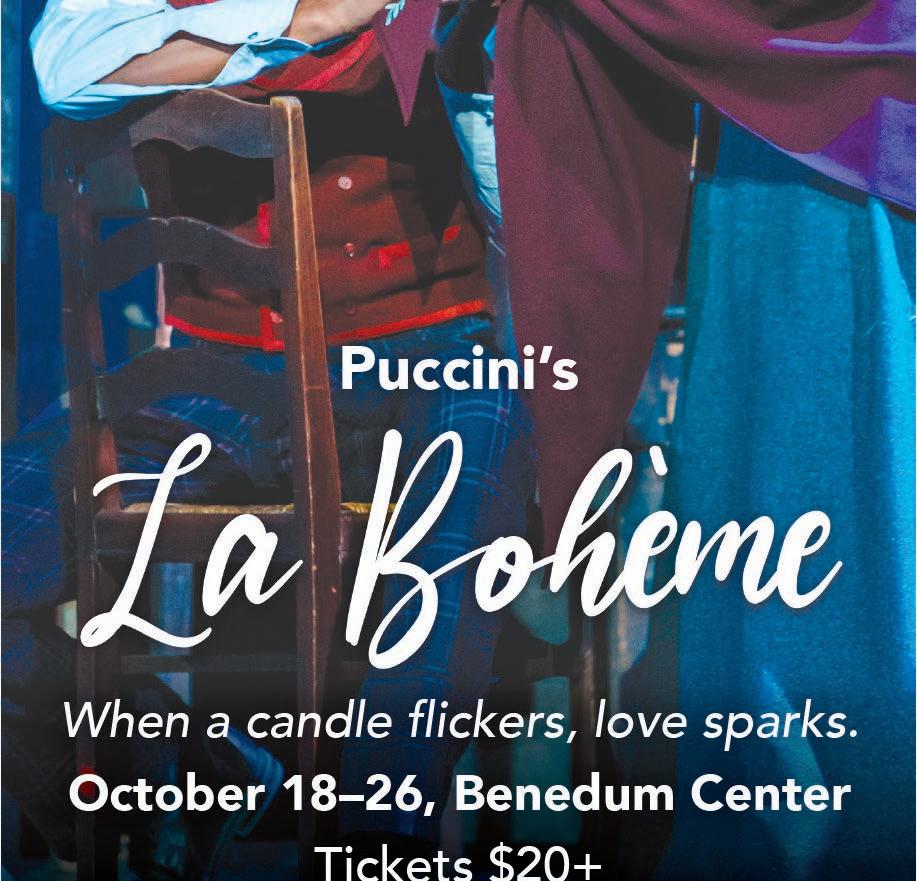

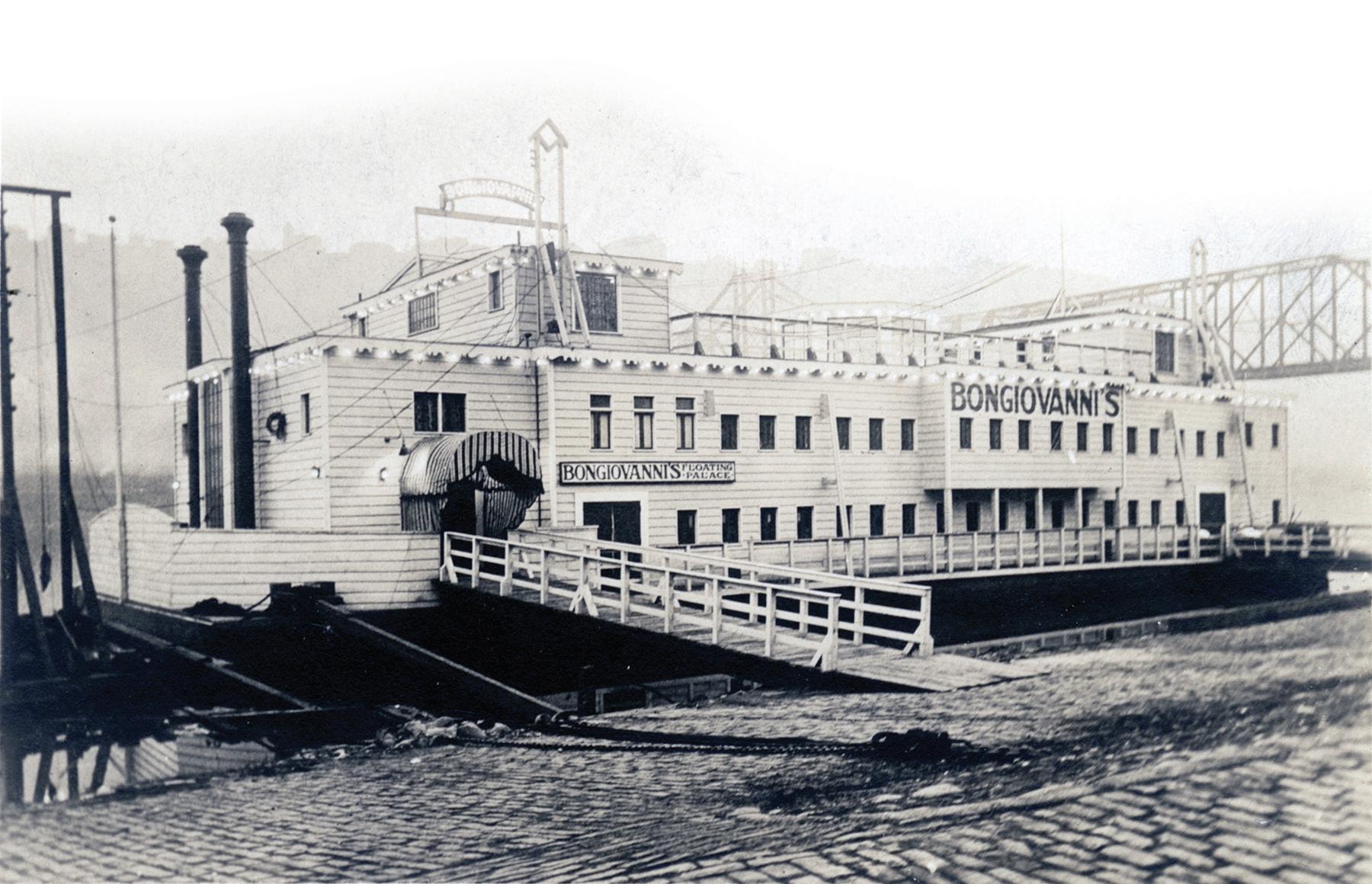
Emerson. “He dropped his surname because he insisted no one could pronounce it and because Emerson was a distinguished name,” recalled showboat captain Billy Bryant in his 1936 memoir.
Novelist Edna Ferber spent time on one of Gaches' former boats, the Goldenroad. She drew on the experience to write Showboat , which became a hit Broadway musical in 1927 and a movie in 1951. Ferber named her fictional showboat after another former Gaches boat, the Cotton Blossom.
Captain Tom Reynolds was another showboat owner with strong Pittsburgh ties. Three generations of his family operated and performed on his popular showboats, which included the Majestic. Built in 1922 at an old Monongahela River coal landing near the Glenwood Bridge, the Majestic became one of the last working showboats in the United States. In 1989, it became a National Historic Landmark.
Not all the flat-bottom boats tied up alongside the three rivers were working barges or entertainment venues. Decades before unhoused people sought shelter along the city’s river trails in precarious encampments, people lived on a type of houseboat known as a shantyboat.
city to which thousands come annually,” wrote sociologist Paul Kellogg at the time.
Many of the city and surrounding area’s unhoused found temporary shelter in downtown boarding houses. “Garages, stables, henhouses, and even a cave were turned into dwellings,” the Pittsburgh Housing
“I THINK WE’RE COMPLETELY UNDERLEVERAGED IN TERMS OF UTILIZING OUR WATERWAYS FOR ENTERTAINMENT.”
Pittsburgh has a long history of people experiencing homelessness. As early as 1907, the sociologists who produced the multi-volume Pittsburgh Survey recognized the problem. It was “worse than no provision by the city itself, sporadic and ineffective oversight of private establishments, summed up the public policy toward homeless men in this
Association wrote in a 1938 report. Because of laws that stigmatized unhoused people, many also found themselves incarcerated in the Allegheny County Workhouse.
Unhoused people and families unable to afford even the most substandard housing also turned to the rivers for shelter. They lived on repurposed barges and boats, many
of them abandoned along the city’s extensive riverbanks.
The vessels were called shantyboats. “A shanty boat is a scow with a small house on it,” wrote Kentucky artist and author Harlan Hubbard in his 1953 book, Shantyboat . Like Cincinnati, St. Louis, and other major river cities, Pittsburgh’s three rivers and substantial riverboat traffic made shantyboat life a viable alternative to squatting in abandoned buildings.
In the 1890s, a substantial shantytown emerged along the Ohio River in Cincinnati. Squatters living on shantyboats and in shacks had been there for more than 20 years before the city displaced everyone and burned the encampment in 1913. It was a temporary solution — in a cycle familiar to many people today, the shantyboats returned.
Historian Susan Morris wrote about the Pittsburgh’s shantyboat dwellers in a 2018 blog post. “The enterprising river citizen was as











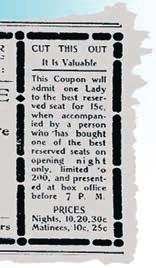
ADVERTISEMENT PUBLISHED IN THE CHARLEROI MAIL, OCTOBER 29, 1910 VIA NEWSPAPERS.COM
Madam Cli ord was a psychic who o ered readings on her “medicine boat,” which was docked in Homestead between c. 1908 and 1929. While not o ering readings on her boat, Cli ord appeared in theaters throughout the country.
likely to scavenge, commandeer and spruce up an abandoned barge as he was to lay out cash for a ‘new’ vessel,” Morris wrote.
“You need a place to live and you don’t have a job, you don’t have money,” Morris said in a 2024 interview about some of the people who lived on Pittsburgh’s rivers. “I really think it was necessity … This wasn’t sort of the Gilded Age saying, ‘Oh, I’d like to live on the water.’”
Pittsburgh’s riverfronts also attracted medicine shows and fly by-night fraudsters who plied their trades while moored here. Medicine shows were popular traveling troupes in the 19th and 20th centuries, and featured actors and musicians who could draw a crowd. The goal, though, wasn’t entertainment — medicine show owners used the entertainers to lure potential buyers for patent medicines and so-called miracle cures that could fi anything from digestive issues to se ual performance and baldness.
“Hundreds of patent medicine peddlers, fortune tellers, clairvoyants, and voodoo practitioners did a brisk business in river cities,” wrote historian Gregg Andrews his 2023

book, Shantyboats and Roustabouts: The River Poor of St. Louis, 1875-1930
Before the Bryant family, whose boats regularly visited Pittsburgh, cast off on their showboats, several members performed with medicine shows. They played guitar and performed magic tricks before launching their successful showboats, after spending a season on Price’s Water Queen while Gaches was its manager. While back on the medicine show circuit, they ended up in the Allegheny River town of West Hickory. There, Sam Bryant built his first boat to take their mules, wagons, and themselves downriver.
Back home in West Virginia, in 1907, the ryants launched their first 1 0 person capacity showboat, the Princess.
Some medicine show hucksters found clever ways to stay afloat. ne of the nation’s best known, Madam Clifford, worked the medicine show and theater circuit in the early 20 th century. By 1911, she had settled down on a houseboat docked in Homestead where she offered readings in person and by mail order.
For 10 cents, people could send her a stamp and their birthdate. In return, adam Clifford would send what she called a “trial reading.”

Folks in Pittsburgh could drop by:
“ adam Clifford will give clairvoyant and business readings at foot of West Street, on medicine boat, Homestead,” read her ads published in local newspapers.
“DEPRAVITY” AND “PERVERSION”
After Prohibition began in 1920, cabaret and restaurant owners like Frank Bongiovanni moved some of their operations onto local rivers, where patrons found booze, music, and fine food atop barges converted into floating nightclubs. Bongiovanni’s Floating Palace, launched in 1923, became the most infamous.
In 1929, gambling entrepreneurs eorge affe and rt ooney leased Bongiovanni’s boat from the John Eichleay Jr. Company and renamed it the Show Boat. Federal agents raided the Show Boat in May 1930, seizing booze and gambling gear after passing by Pittsburgh police officers hired by the gamblers and who were posted at the gangplank.
The week before the Show Boat raid, local law enforcement officers raided the Manitou. Like the Show Boat, it, too, was owned by


the Eichleay company. A few years earlier, Gaches had sold the Manitou and its towboat, the Red Wing, to ichleay after a ma or refit done at the company’s Hays boatyard.
The May 5, 1930 raid on the anitou yielded a trove of adult films and gambling paraphernalia. It was a time of flappers and of pushed boundaries, with dancers flouting morals laws with increasingly skimpy costumes.
“County detectives raided the barge … which for months has been the scene of shows in which the costuming of the chorus hasn’t been any problem to the promoters because there weren’t any costumes,” the Post-Gazette reported.
Muckraking journalist Walter Liggett was in town when both raids went down. “There isn’t a form of depravity that hasn’t been put on a dividend-bearing basis in Pittsburgh, and even perversion is made to pay a profit,” iggett wrote in a widely read magazine article. “For months a boat called the Manitou, which docked in the Monongahela River near the foot of Wood Street, pulled out into the river every night with from three hundred to five hundred cash customers aboard and a nightly ‘show’ was put on which consisted of naked dancing and indescribably vile motion pictures.”
Much of Pittsburgh’s early colorful culture has disappeared. There are no historical markers that tell the stories of Pittsburgh’s showboats and floating casinos. cept for the amin Science Center’s Requin submarine and the ivers of teel’s plorer riverboat, there are no historic boats moored along the rivers that tell this story. In fact, it’s possible to get more of Pittsburgh’s riverfront history 470 miles downstream in Cincinnati. There, in a popular riverfront park,
historical plaques in the Riverboat Hall of Fame discuss Pittsburgh boatbuilding and its role as a riverboat destination.
Though the technology and uses are different, vestiges of Pittsburgh’s past as a dominant river city survive. When Alan Bernstein’s family went into the riverboat business in 1979, they bought their first boat from Gateway Clipper. “We have bought several things from Gateway over the years,” says Bernstein, whose e cursion boats are based in ewport, y., across the hio iver from Cincinnati.
The old Gateway Clipper boat wasn’t the Bernsteins’ only tie to Pittsburgh. Between 1977 and 2008, the Bernsteins operated a restaurant docked in neighboring Covington, y.
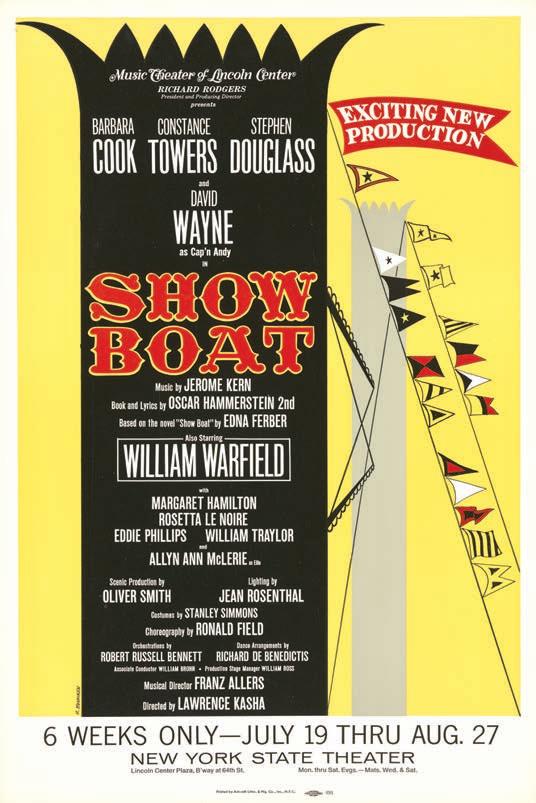


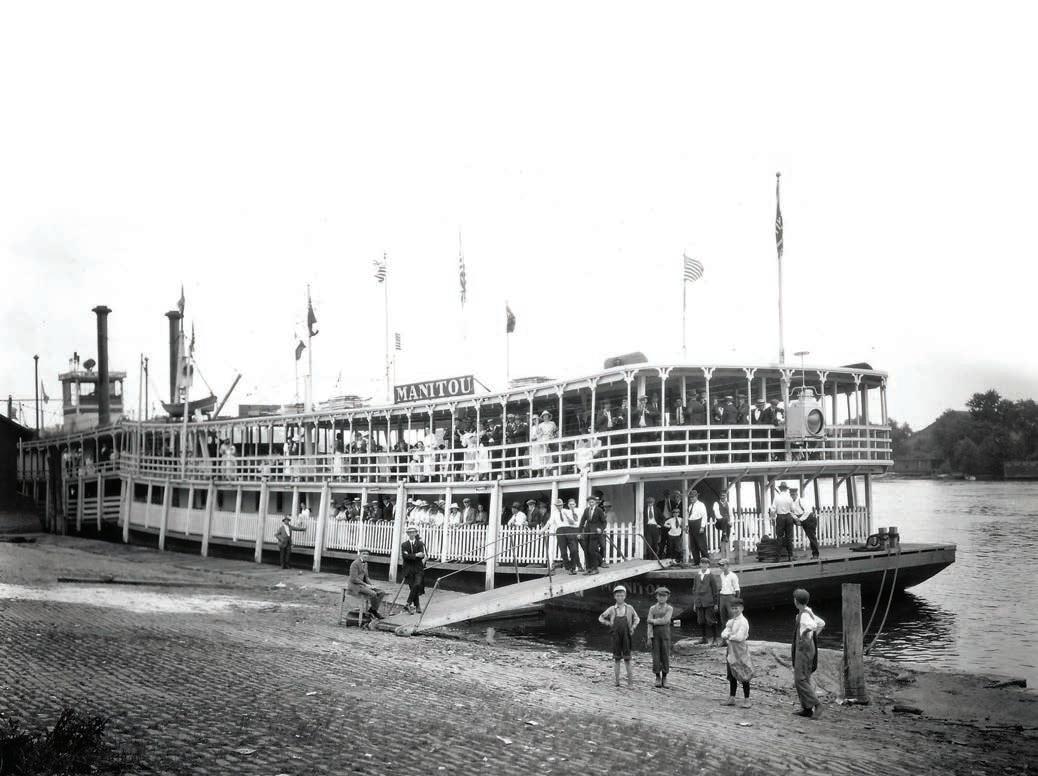



Named the Mike Fink after a legendary 19 th century riverboat operator, the sternwheel steamboat was built on Neville Island in 1936. Originally it had been named for Pittsburgh foundry and riverboat owner John W. Hubbard.
With city- and county-led removals of the encampments that succeeded shantyboats, the slow gentrification of old industrial sites, and the arrival of new family-friendly entertainment venues like Riverlife’s Shore Thing, Pittsburgh’s riverfronts would be unrecognizable to a 1920s steamboat captain. And many believe erasing or forgetting Pittsburgh’s colorful riverfront history is a lost opportunity. “I think we’re completely under-leveraged in terms of utilizing our waterways for entertainment,” says Riverlife’s Galluzzo. “I think, with a little bit of effort, folks can really access a clear and, in some ways, objective view of that history.” •





From art and design to food, sauna, and song, the Steel City offers plenty of ways to channel a northern mood
After what felt like an unending summer, sweater weather has arrived. As we lean into the chill, it’s the perfect time to notice Pittsburgh’s surprisingly Nordic side.
From a private collection turned public at The Frick Pittsburgh to meatballs and mackerel at Fet-Fisk, steam rising from Bad Sauna, and hymns sung at Scandinavyinz, the far north is closer than it looks.
On a recent crisp morning in Point Breeze, the Frick Art Museum didn’t feel like a museum at all. Stepping into The Scandinavian Home: Landscape and Lore, you half e pect to be offered coffee. There’s no iking armor or I minimalism here, but something much homier.
“Home is such a multivalent term,” Dawn Brean, chief curator and director of collections at The Frick, tells Pittsburgh City Paper. “It can be your physical residence. It can also be the land itself and the national territory. ome is also a concept a feeling, an intangible sense of comfort and security. In that way, many Nordic citizens at this time viewed the idea of home as the communities they built through a shared commitment to social democracy. A happy home contributed to the health of the nation.”
The galleries are staged like rooms: a painted pine chair here, a handwoven tapestry there, cabinets curling with mythic vines. Snowy landscapes by Gustaf Fjaestad and kseli allen allela hang beside glassware and ceramics, the “fine art” never uite separated from the everyday.
The show, running through an. 11, 0 , is the first public look at avid and Susan Werner’s private collection, with more than 100 works spanning the late 18th to mid-20th centuries. Brean and consulting scholars Patricia Berman and Michelle Facos built the exhibition around a deceptively simple idea: home.
“One exciting and rare work we will have on display is a stunning tapestry of a landscape in moonlight designed by Gustaf Fjaestad and woven in 1905,” Brean says. “The Werners’ collection also has a great focus on female artists … milie undt, eda t ernschant , ilma af lint.”
The Frick makes the case that these works were political. In the late 1 th early 0th century, when enmark, orway, weden, and Finland were defining themselves as modern nations, artists and craftworkers reached for the local and the folkloric to argue for authentic identity.
“Landscapes were a major category of 19th-century Nordic painting and emphasized a strong connection between the natural environment and national identity,” Brean notes. “Stunning landscapes feature the dazzling northern skies, snow-blanketed hills, and the rugged fjords, waterways, and mountains of Norden.”
rean points to tto esselbom’s “ unset in rmland.” esselbom was among a group of artists passionate about the preservation of their national heritage, and this painting epitomizes the very particular idea of Nordic light. “ unlight behaves differently at these higher latitudes,” rean says, “resulting in stunning sunsets and lingering twilights.”
If you want to go deeper than a single lap through the galleries, The Frick’s calendar offers plenty tours, lectures, forest bathing, and more. n an. , in partnership with loomfield’s Fet Fisk, the museum offers a culinary talk and tasting inside the exhibition.
nd if that feels a lot like fika the wedish ritual of slowing down over coffee and pastries it’s by design.
It’s also the perfect launchpad for noticing something else in a city that prides itself on immigrant histories, Pittsburgh has a Nordic pulse — small, but no less enduring.
Fet-Fisk has become Pittsburgh’s north star for contemporary Nordic cooking: cured fish, rye, foraged greens, aquavit at the bar. The East End popup-turned-restaurant has drawn plenty of national press since its launch, and is still booking heavy most nights.
Chef-owner Nik Forsberg calls the food “semi-Swedish, loosely Nordic.”
“Our food is more rooted in classic European cooking with nods to Nordic flavors and themes,” he tells City Paper.
Still, he sees the restaurant in dialogue with Scandinavian traditions that emphasize local sourcing and seafood. “In our context, our locale is western Pennsylvania and our primary regional focus is the produce,” he explains. “Seafood is also highly celebrated in the Nordic countries … a goal of ours was to increase Pittsburghers’ exposure and understanding of seafood.”
That mission became clear early on with his pickled mackerel dish. A direct homage to northern Europe’s devotion to pickled fish, it quickly turned into a signature item, meant to demystify a flavor unfamiliar to many Pittsburgh diners.
Some of the most traditional Nordic recipes he’s cooked have also struck a chord. On the opening menu, Forsberg featured Jansson’s Temptation, a humble Swedish casserole of potato, caramelized onion, anchovy, cream, and breadcrumbs, usually served in winter. “It’s a dish that is truly greater than the sum of its parts,” Forsberg says, “and it was a joy to hear guests continue to crave it once we moved on to lighter fare for spring.”
By June, he gave in to another inevitability: Swedish meatballs. “The amount of times I’ve heard, ‘Swedish restaurant? Are you gonna have meatballs on the menu?’ caused me much resistance to actually serving the dish,” Forsberg admits. Yet on Sundays, Fet-Fisk now serves meatballs made from fresh ground strip loin trim, accompanied with lingonberries, pickled cucumber, and a light brown cream sauce. “Most customers’ familiarity with Swedish meatballs comes from trips to IKEA,” he says. “So serving it now is a chance to use that point of reference as a gateway to an experience that often surpasses their expectations.”
Still, Forsberg insists the point isn’t fidelity to canon but the experience at the table. “There is nothing greater or more powerful than coming together over a meal. I hope our restaurant can either re-affirm or re-awaken that feeling in our guests.”
Beyond the table, another piece of Nordic life has taken root in the city….
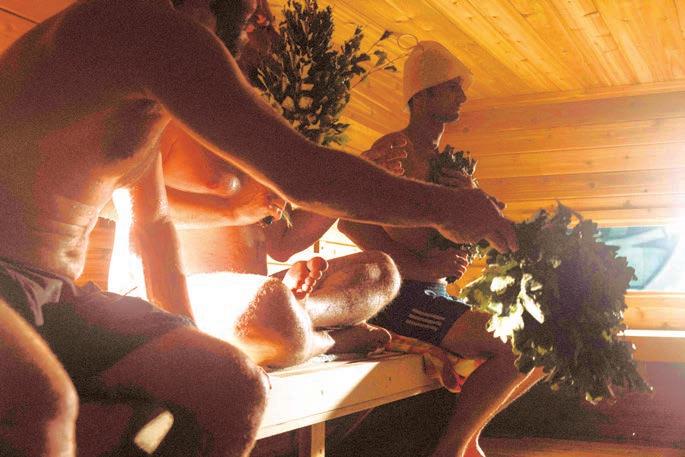

In Point Breeze, Bad Sauna offers the one Nordic practice everyone insists is essential: the sauna. The ritual is unmistakably Finnish. “Sauna was where women gave birth, where people healed their ailing bodies, gathered with friends and family, and where bodies were prepared for the afterlife,” founder Greg Schaffer tells CP. “It’s also where magic happens, according to the Finnish national epic, the Kalevala.”
Schaffer grew up in Squirrel Hill knowing almost nothing about sauna. It wasn’t until a stint in San Francisco, at Archimedes Banya, that he fell for the ritual of hot and cold. Returning home, he realized Pittsburgh once had a schvitz culture of its own, with Russian-Jewish bathhouses in the Hill District. “It’s been fun chasing down stories from the old schvitzes and connecting with ghosts from the Hill,” he says. “I see my work as helping to revive this legacy.”
The space is rigorously Finnish, built with master designer Lassi A. Liikkanen, fitted with an IKI stove, and following the “Law of Löyly,” the principle of perfect steam. “I try to honor the Finnish reverence for the sauna,” Schaffer says.
Sessions are communal, unstructured, and accessible. Unlike spas that promise optimization, Bad Sauna insists on pure leisure. “Wellbeing is not only or always about achievement,” Schaffer says. “It’s about connecting with your body, with others around you, and feeling good.”
Bad Sauna’s space may be the closest you’ll get to Helsinki or Stockholm without a boarding pass. But the city also has a community that keeps Scandinavian traditions alive in song, food, and fellowship.
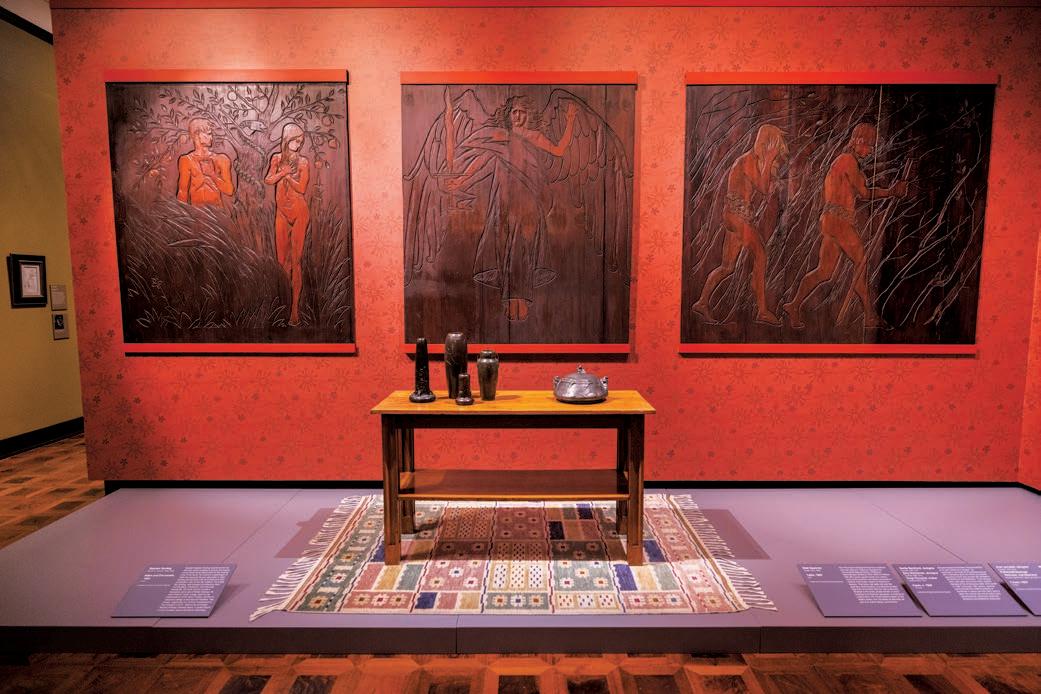
The Scandinavian Society of Western Pennsylvania , a ffectionately nicknamed Scandinavyinz, has been gathering since 1983. President Eva Robinson tells CP that the group’s calendar “runs on ritual” with celebrations “10 months out of the year.”
“IT’S COZY AND COMFORTABLE, YES, BUT MORE PSYCHOLOGICAL THAN ANYTHING … IF YOU RUN INTO AN OLD CLASSMATE AND START TALKING, THAT IS HYGGE."
In October, Nordic Night brings flags circling the room and national anthems sung before a sit-down dinner of fish, potatoes, and European dishes. December features the society’s Christmas party, a members’ buffet heavy with Scandinavian favorites like herring and baked goods. February belongs to Fastelavn, the Danish children’s carnival where kids dress up and strike a barrel until candy spills out. “The first hole makes you Cat Queen, the final knock-down makes you Cat King,” Robinson explains. In May, members gather to mark Norwegian Constitution Day, and midsummer is celebrated with a picnic at Aspinwall Fireman’s Memorial Park.
Though its name highlights Scandinavia, the society welcomes everyone. Members have included Swedes, Norwegians, Danes, Finns, and even Icelanders in past years, along with plenty of curious non-Nordic Pittsburghers. Membership costs $25 for individuals and $30 for families per year.
For Robinson, the heart of these gatherings is hygge, the Danish concept of comfort and coziness that has spread across Scandinavia and resonates throughout the Nordic world. “It’s cozy and comfortable, yes, but more psychological than anything … if you run into an old classmate and start talking, that is hygge,” she says. “Sitting alone while it’s snowing outside and you’re warm, that is hygge too.”
That cultural thread carries into Pitt’s Cathedral of Learning, where the Swedish and Norwegian Nationality Rooms sit among 31 classrooms designed with immigrant communities.
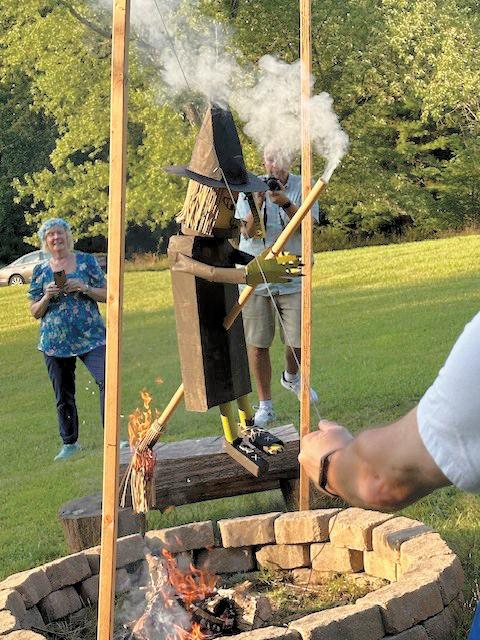
Inside Pitt’s Cathedral of Learning, the Swedish and Norwegian Nationality Rooms are hidden in plain sight.
The Swedish Room, dedicated in 1938, recreates buildings still visitable in Sweden’s Skansen Museum, making it a living link to history. Its standout feature is the series of paintings by Olle Nordmark, a Swedish immigrant to the U.S. in the 1920s. Drawing on decorative motifs from historic houses at Skansen, Nordmark created allegories of Justice, Judgment, and Knowledge, alongside the agi and t. atrina. The result offers a colorful glimpse into 18th-century folk painting.
The orwegian oom evokes the warmth of a cottage a fireplace, evergreen wood paneling, and ceilings enlivened with rosemaling, the traditional floral painting on spruce planks. Norwegian folk art details include a reproduction of a 1695 wedding blanket, modeled on the original in the folk museum at Lillehammer.
They aren’t just for show. Both rooms still host classes, so students take notes under symbols of Nordic heritage. When not in use, the public can book tours to step inside.
Many Americans are fortunate to have dental coverage for their entire working life, throughemployer-provided benefits. When those benefits end with retirement, paying dental bills out-of-pocket can come as a shock, leading people to put off or even go without care.
Simply put — without dental insurance, there may be an important gap in your healthcare coverage.
Look for coverage that helps pay for major services. Some plans may limit the number of procedures — or pay for preventive care only.
Look for coverage with no deductibles. Some plans may require you to pay hundreds out of pocket before benefits are paid.
Shop for coverage with no annual maximum on cash benefits. Some plans have annual maximums of $1,000.
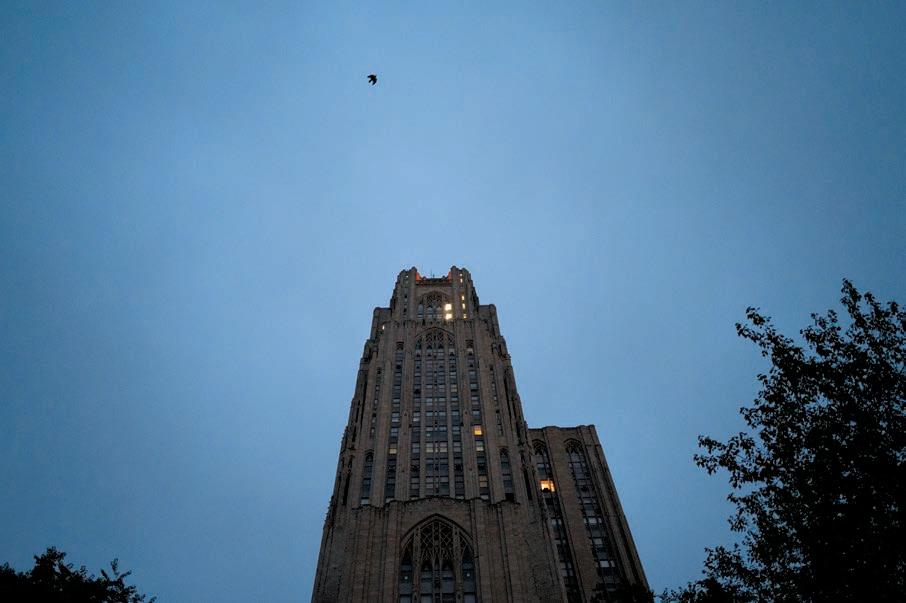
Medicare doesn’t pay for dental care.1
That’s right. As good as Medicare is, it was never meant to cover everything. That means if you want protection, you need to purchase individual insurance.
Early detection can prevent small problems from becoming expensive ones.
The best way to prevent large dental bills is preventive care. The American Dental Association recommends checkups twice a year.
Previous dental work can wear out.
Even if you’ve had quality dental work in the past, you shouldn’t take your dental health for granted. In fact, your odds of having a dental problem only go up as you age.2
Treatment is expensive — especially the services people over 50 often need.
Consider these national average costs of treatment ... $222 for a checkup ... $190 for a filling ... $1,213 for a crown.3 Unexpected bills like this can be a real burden, especially if you’re on a fixed income.
Helps keep more money in your pocket!
Go to any dentist you want
On Fri., Oct. 17 and Sun., Oct. 19, the Pittsburgh Symphony Orchestra presents Sibelius’ Finlandia, a musical paean to Finnish identity, along with Sibelius’s Sixth Symphony, Stravinsky’s Violin Concerto, and The Observatory by Caroline Shaw. The program is conducted by Finnish maestro Dalia Stasevska, with Leila Josefowicz as soloist.
For those two nights, the air in Heinz Hall will tilt northward. Put it all together — the art, the food, the sauna, the spirit — and the city offers a surprisingly ordic day. asically, fika in the Steel City. •











Fall is usually the time to get your annual vaccinations, including the COVID-19 booster. But this year, under the Trump administration, Pennsylvanians are navigating conflicting sets of C I 1 vaccine guidelines, new restrictions, and barriers to access. Recently, Pa. Gov. Josh hapiro received national attention for his actions to safeguard vaccine access and curb confusion statewide.
So what does the local landscape currently look like? Pittsburgh City Paper spoke with the Allegheny County Health Department, reviewed the ongoing federal saga, and checked federal and state recommendations to get a clearer picture of the situation heading into peak respiratory virus season.
Under Pennsylvania state law, pharmacists can administer vaccines based on recommendations from the federal dvisory Committee on Immuni ation Practices CIP . This committee of independent e perts advises the C C, providing guidance for all licensed vaccines and their “appropriate use,” according to its website. ACIP’s recommendations become official policy once adopted by the C C.
In June, Health and Human Services (HHS) Secretary Robert F. Kennedy r. known for his decades of anti vaccine advocacy and circulating medical misinformation — removed all 1 sitting members of CIP, stating the move was necessary to “restore public trust” in vaccine science. ACIP’s COVID-19 vaccine recommendations had not yet been issued, leaving Pennsylvania pharmacies unable to give the updated shots.
Compounding the confusion, in ugust, the F approved C I 1 vaccines with new imposed restrictions, limiting access to to people 65 or older or with certain underlying health conditions that increase severe







ACHD recommends the COVID-19 vaccine for all children aged 6 months to 2 years, and for all adults 19 and older. In contrast to broader recommendations from past years, children between the ages of 2 to 18 are only encouraged to get the shot under certain conditions.



“UNFORTUNATELY, OUR FEDERAL DECISION-MAKERS HAVE CHOSEN TO UNDERMINE TRUST IN VACCINES, DOCTORS, AND SCIENCE ITSELF.”



disease risk. Initially, this led major pharmacy chains in Pennsylvania to require a prescription for the COVID-19 vaccine.
Enter Shapiro, who, in early September, intervened to bypass federal vaccine restrictions.
“Health care decisions should be up to individuals — not the federal government and certainly not RFK Jr.,” Shapiro stated in a Sept. 3 press release. At Shapiro’s urging, the Pennsylvania State Board of Pharmacy approved new “competent authorities” for establishing statewide vaccine guidelines, naming medical associations including the American College of Obstetricians and Gynecologists, American Academy of Pediatrics, and American Academy of Family Physicians.
Pennsylvania then joined the newly-formed Northeast Public Health Collaborative, a group of health agencies from seven states setting their own vaccine and health guidelines. A similar coalition, the West Coast Health Alliance, was established in September by the governors of California, Oregon, Washington, and Hawaii.
Following nationwide controversy and uncertainty, on Oct. 6, the newly installed ACIP voted to shift away from broad federal COVID-19 vaccine guidelines and toward individual-based decision-making.
“Informed consent is back,” stated Acting CDC Director and Deputy Secretary of HHS Jim O’Neill in an Oct. 6 press release. The CDC is expected to recommend that people seeking the shot consult with a healthcare provider, and those administering vaccines may require “proof of a discussion,” though not necessarily a prescription, under new federal guidelines (still pending at press time).
In the meantime, Gov. Shapiro signed an Oct. 1 executive order ensuring Pennsylvania residents “have regular, easy access to safe and effective vaccines” based on national medical associations’ recommendations, and apart from federal guidelines.
According to Dr. Barbara Nightingale, Deputy Director for Clinical Services with the Allegheny County Health Department (ACHD), the county follows “evidence-based guidance” from the Pennsylvania Department of Health (DOH) and other medical organizations named in Shapiro’s recent executive order.
“For children between the ages of 2 to 18, we recommend vaccination for those at higher risk of severe illness and fully support families who choose to vaccinate their children,” Dr. Nightingale tells City Paper Under DOH guidelines, COVID-19 vaccination is also recommended for pregnant people. Getting vaccinated against COVID-19 during pregnancy was also recommended in ACIP’s recent guidelines, reversing an earlier recommendation made by Robert F. Kennedy and surprising some experts
s it stands, the ffordable Care ct mandates that most private insurers cover vaccines recommended by ACIP, and it’s expected most Americans with health insurance should be able to receive the vaccine at no cost. Medicaid also currently provides ACIP-recommended vaccines at no cost.
A Sept. 26 DOH fact sheet states that the Pennsylvania Insurance Department “expects all insurers that issue health policies in Pennsylvania providing coverage of health care services to continue to cover the COVID19 vaccine.” DOH recommends contacting your health insurance provider to verify coverage.
Pennsylvania’s Medicaid (Medical Assistance) program, both HealthChoices managed care and fee-for-service programs, cover the vaccine.
The Allegheny County Health Department has COVID-19 vaccines available for all residents at the Immunization Clinic on First Avenue in Downtown Pittsburgh. Major area pharmacy chains including CVS and Giant Eagle — which, this season, is also absorbing hundreds of former Rite Aid customers — also have the shot available.
Though CVS began administering the COVID-19 vaccine again under Pennsylvania’s new guidance, patients must still self-attest they are eligible for the 2025/26 COVID-19 vaccine under FDA guidelines.
According to Dr. Nightingale, county trends in COVID infections “mirror those seen nationally” and typically the county experiences “an increase in reported infections and associated hospital visits during the winter months.”
Last month, 599 COVID-19 infections were reported, compared to 219 in July and 387 in August, though there have been fewer emergency room visits compared with earlier in September. Nightingale says we should expect an increase, especially with the upcoming holiday season. ACHD shares local respiratory virus illness numbers weekly on its online dashboard
At the moment, Pennsylvanians have more vaccine access than residents of some other states, especially as state governments form independent health organizations and break away from what’s been described as the “politicization” of the CDC.
ocally, leaders have praised ov. hapiro’s efforts, including Pa. ep. an Frankel (D-Allegheny), who “applauded” the launch of the Northeast Public Health Collaborative.
“Unfortunately, our federal decision-makers have chosen to undermine trust in vaccines, doctors, and science itself,” Frankel stated in a Sept. 18 release. “That makes this multistate effort even more urgent, because lives are at stake.” •

FILM • NORTH SIDE



Rot and Resurrection: Films on Future









BY CP STAFF




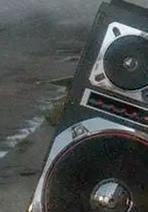


Idea Furnace Retrospective. 10 a.m.–7 p.m. Continues through Jan. 9., 2026. Pittsburgh Glass Center. 5472 Penn Ave., Friendship. Free. pittsburghglasscenter.org
Opening Reception: Wavelengths, Rethinking the Rotunda III, and Earth and Ether: The Art of Lucille and Virgil Cantini 5-7 p.m. Continues through Jan. 30, 2026. University of Pittsburgh-Frick Fine Arts Building. 650 Schenley Dr., Oakland. Free. uag.pitt.edu
Pittsburgh Arts and Lectures presents Tahirah J. Walker. 7 p.m. Carnegie Library Lecture Hall. 4400 Forbes Ave., Oakland. Free. Registration required. pittsburghlectures.org
An Evening with Dave Molinari and The Pittsburgh Penguins: An Illustrated Timeline 7-8 p.m. Riverstone Bookstore. 8850 Covenant Ave., McCandless. Free. Registration required. riverstonebookstore.com

FILM • DOWNTOWN
Urchin 5 p.m. and 7:30 p.m. Continues through Thu., Oct. 23. Harris Theater. 809 Liberty Ave., Downtown. $10-13. trustarts.org
PARTY • OAKLAND
Phipps After Dark: House of Haunts. 7-10 p.m. Phipps Conservatory and Botanical Gardens. One Schenley Dr., Oakland. Included with regular admission. phipps.conservatory.org
Show mom that it’s not a phase during the live band Emo Night at SideQuest on 44th
Described as the “ultimate Warped Tour experience,” the event covers all the scene kid favs, including My Chemical Romance, Taking Back Sunday, Blink 182, Fall Out Boy, Panic! At the Disco, and more. Bring your friends and relive the days of flat-ironed hair, MySpace profiles, and unfortunate lip rings. 8 p.m. Doors at 7 p.m. 146 44th St., Lawrenceville. $15 in advance, $20 at the door. 21 and over. sidequestpgh.com
Hauntings by Rebecca Shapass 8-10 p.m. Mattress Factory. 509 Jacksonia St., North Side. $10, free for members. mattress.org
KIDS • HIGHLAND PARK
ZooBoo 10 a.m.-3 p.m. Pittsburgh Zoo and Aquarium. 7370 Baker St., Highland Park. Included with regular admission. Costumes encouraged. pittsburghzoo.org
MARKET • GARFIELD
Roboto Punk Rock Flea Market 12 p.m. Mr. Roboto Project. 5106 Penn Ave., Garfield. Free. All ages. therobotoproject.com
OUTDOORS • HIGHLAND PARK
CitiParks Track and Treat. 12-4 p.m. Bud Harris Cycling Track. 1401 Washington Blvd., Highland Park. Free. All ages. Costumes encouraged. pittsburghpa.gov
PARTY • NORTH SHORE
The Last Splash, A Farewell Celebration of Shore Thing 12-5 p.m. Allegheny Landing Park. Two Federal St., North Shore. Free. shorething.riverlifepgh.org
LIT • NORTH SIDE
City of Asylum highlights the multifaceted world of writing during the latest LitFest. The annual event returns with esteemed guests, including poet and comic book author Yona Harvey, Booker Prize-winning novelist Kiran Desai, and City of Asylum’s new writers-inresidence. Discover Indigenous authors, learn the art of translation, see poems performed by ASL interpreters, and more. 1 p.m. Continues through Sun., Oct. 19. 40 W. North Ave., North Side. Free. Registration required. cityofasylum.org

Prime Stage Theatre presents Freedom House Ambulance Service: Putting History on the Stage. 2-3 p.m. Carnegie Library of Pittsburgh-Hill District. 2177 Centre Ave., Hill District. Free. primestage.com
PARTY • HOMESTEAD
Nina and Tree’s ‘90s Cabaret. 7-10 p.m. The Glitterbox Theater. 210 W. Eighth Ave., Homestead. $10-20. theglitterboxtheater.com
MUSIC • STRIP DISTRICT
Calliope presents Damn Tall Buildings 7:30 p.m. The Original Pittsburgh Winery. 2809 Penn Ave., Strip District. $45. pittsburghwinery.com
MAGIC • OAKMONT
Smokus Pocus 8-9:15 p.m. The Oaks Theater. 310 Allegheny River Blvd., Oakmont. $39.19. 21 and over. theoakstheater.com
FILM • SEWICKLEY
Carnegie Screenwriters Showcase 1-5 p.m.
The Lindsay Theater and Cultural Center. 418 Walnut St., Sewickley. Free. Reservations required. thelindsaytheater.org
MUSIC • DOWNTOWN
The Magic of Motown 6 p.m. Byham Theater. 101 Sixth St., Downtown. $60.77-94.99. trustarts.org
MUSIC • UPTOWN
Mumford and Sons with Stephen Sanchez and The Barr Brothers. 7:30 p.m. PPG Paints. 1001 Fifth Ave., Uptown. Tickets start at $36. ppgpaintsarena.com
MUSIC • NORTH SIDE
Sound Series: Brian Dunne with Dead Gowns. 8 p.m. Doors at 7 p.m. The Andy Warhol Museum. 117 Sandusky St., North Side. $20-25. warhol.org


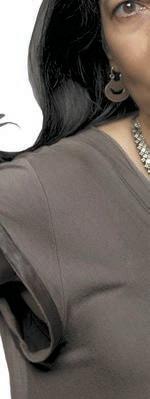











at The Original Pittsburgh

MON., OCT. 20
FILM/MUSIC • NEW KENSINGTON
Paul Bielatowicz’s Nosferatu Undead 7 p.m.
Doors at 6 p.m. Preserving Underground. 1101 Fifth Ave., New Kensington. $25.15. preservingconcerts.com
FILM • LAWRENCEVILLE
Let Bill Nunn tell you the story of Right Hand, Left Hand when Row House Cinema presents a special memorial screening of Do the Right Thing. The late actor and Pittsburgh native plays the iconic character of Radio Raheem in Spike Lee’s breakout 1989 film, regarded for its depiction of racial tensions in the Bedford-Stuyvesant section of Brooklyn. The event takes place on Nunn’s birthday, commemorated as Bill Nunn Day in Pittsburgh. 7 p.m. 4115 Butler St., Lawrenceville. $14. rowhousecinemas.com
MUSIC • NORTH SIDE
So Totally, Loadcard, Sorry Face, and Brake Run. 8 p.m. Doors at 7 p.m. The Government Center. 715 East St. North Side. $10. thegovernmentcenter.com
MUSIC • LAWRENCEVILLE
Jensen McRae with Kahleah Lee 8 p.m. Doors at 7 p.m. Thunderbird Music Hall. 4053 Butler St., Lawrenceville. $35.32-41.23. thunderbirdmusichall.com
MUSIC • OAKLAND
Chamber Music Pittsburgh presents Sphinx Virtuosi with Sterling Elliott 7:30 p.m. Carnegie Music Hall of Oakland. 4400 Forbes Ave., Oakland. $57.10-46.90. chambermusicpittsburgh.org
MUSIC • DOWNTOWN

OCT.MON., 20

Marel Hidalgo Organ Trio 5 p.m. Lounge at the Greer Cabaret. 655 Penn Ave., Downtown. Free. trustarts.org
MUSIC • ALLENTOWN
Chain with Fake Grave and Mezzanine 8 p.m. Doors at 7 p.m. Bottlerocket Social Hall. 1226 Arlington Ave., Allentown. $15 in advance, $18 at the door. bottlerocketpgh.com
MUSIC • SOUTH SIDE
Pretty Jane 8 p.m. Doors at 7 p.m. Club Cafe. 56-58 South 12th St., South Side. $15 in advance, $18 at the door. 21 and over. clubcafelive.com








(Master’s w/ 3 yrs exp or Bach w/ 5 yrs exp; Majors: Bus. Admin, Finance, or equiv) - Cuddy, PA. Job entails working w/ & reqs exp incl: credit evaluation, risk mitigation, regulatory compliance, financial forecasting, budget management, variance analysis, aiding decision-making, financial reporting, & tracking & reporting financial performance against planned budgets. Send resumes to SantopSeal Corporation, Attn: HR, 3 Nicholson Dr, Cuddy, PA 15031
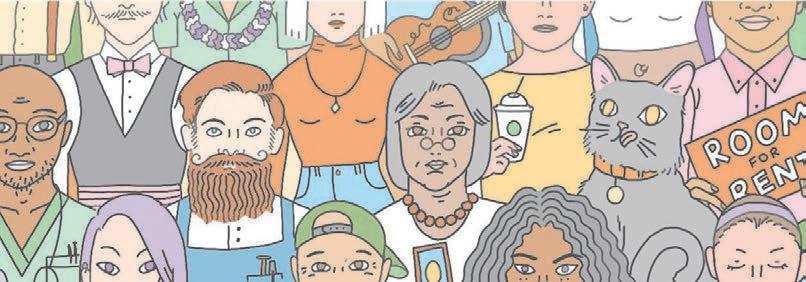




(Bachelor’s in Chemical Engg or equiv w/ 3 yrs exp) - Cuddy, PA. Job entails working w/ & reqs exp incl: SAP for production tracking & inventory oversight, SS Reactors, GLRs, vacuum dryers, operational e iciency & safety, hazardous material handling, safety protocol development, batch processing, BPCR, process optimization, overseeing production parameters (temperature regulation & pH control), & presenting technical reports. Send resumes to SantopSeal Corporation, Attn: HR, 3 Nicholson Dr, Cuddy, PA 15031

NORTH HILLS TOWNHOME
2 Bedroom, 1 Bath, Garage, Laundry and Yard
Contact at: 412-334-0615
IN The Court of Common Pleas of Allegheny County, Pennsylvania: NO. GD-25-9276, In re petition of Miranda Lea Gula, change of name to Miranda Lea McAlister.
To all persons interested: Notice is hereby given that an order of said Court authorized the filing of said petition and fixed the 5th day of November, 2025, at 9:30 a.m, as the time and the Motions Room, City-County Building, Pittsburgh, Pennsylvania, as the place for a hearing, when and where all persons may show cause, if any they have, why said name should not be changed as prayed for.
A happy guy who loves good food, great conversation, and even better company — just looking for someone who enjoys the same interests! Give me a call at 412-313-4320 —and if I miss your call, leave a message and I’ll get back to you soon!
NAME CHANGE
In the Court of Common Pleas of Allegheny County, Pennsylvania: GD-25-009664.
In re: Petition of Felipe Kwang Il Yoon, for change of name to Quinn Iseul Yoon. To all persons interested: Notice is hereby given that an order of said Court authorized the filing of said petition and fixed Wednesday, November 12, 2025, at 9:30 a.m. as the time and the Motions Room, City-County Bldg., Pittsburgh, PA 15219, as the place for a hearing, when and where all persons may show cause, if any they have, why said name should not be changed as prayed for.
White male, 56, health conscious, non-smoker, non-drinker. I’m very caring, talkative and loving. I enjoy oldies, nature, animal-lover. The simple things in life make me happy. Desire a girl with similar interest. 412-781-5989, best time 7p.m.-8:30p.m.
NAME CHANGE
IN The Court of Common Pleas of Allegheny County, Pennsylvania: NO. GD-25-009579, In re petition of Robert Joseph Sousa, change of name to Robert Joseph Susa. To all persons interested: Notice is hereby given that an order of said Court authorized the filing of said petition and fixed the 12th day of November, 2025, at 9:30 a.m, as the time and the Motions Room, City-County Building, Pittsburgh, Pennsylvania, as the place for a hearing, when and where all persons may show cause, if any they have, why said name should not be changed as prayed for.

ESTATE NOTICE
ESTATE OF HRUBOVCAK, LORETTA, A. A/K/A IF NECESSARY LORETTA ANN HOOD. DECEASED OF PITTSBURGH, PA No. 022401053 of 2023
Extr. 6th Ochiltree Way, Pittsburgh, PA, 15205
ESTATE NOTICE
ESTATE OF MCDERMOTT, GARY, BERNARD A/K/A IF NECESSARY, GARY MCDERMOTT DECEASED OF PITTSBURGH, PA No. 022506123 of 2025.
Extr. Louise Didiano 1748 Pioneer Ave, Pittsburgh, PA, 15226
Extra Space Storage will hold a public auction to sell the contents of leased spaces to satisfy Extra Space’s lien at the location indicated: 1212 Madison Ave, Pittsburgh, PA 15212 on 11/05/2025 at 1:30 pm for 115 Michael Mubel, 2022 Samantha Payne, 2064 Romonda Massey, 3135 Ladasha Howard, and 6090 James Williams. The auction will be listed and advertised on www.storagetreasures.com. Purchases must be made with cash only and paid at the above referenced facility in order to complete the transaction. Extra Space Storage may refuse any bid and may rescind any purchase up until the winning bidder takes possession of the personal property.
ESTATE NOTICE
ESTATE OF BELL, FRED JOSEPH, DECEASED OF PITTSBURGH, PA No. 022506009 of 2025. Rosemary E Borelli Extr. 1807 Orchid Street, Pittsburgh, PA 15207

LookingfortheWoman fromMyDream Fall2025:Wemetina dream.Youwerethe beautiful25-30SWFwho believesinJesus,wantsa family,andreadthisad. I'mthe35-year-old,5'9" fitdoctorwithexcellent bedsidemanner-loverof bikerides,nature,music, andfollowingChrist's teachings.
Ifthissoundsfamiliar, let'smakethatdream cometrue.
Johnruberg17@gmail.co m https://m.youtube.com/w atch?v=xJa70CBA4VM
BY BRENDAN EMMETT QUIGLEY // BRENDANEMMETTQUIGLEY.COM








toward
Cat-eating TV character
Little shots
Cooking implement
Fire-breathing monster
Dream team game?
Hoarse
Joy Division singer ___ Curtis
Insect that does a waggle dance
Familia member
45.
Ink squirters
48. Accordion-style pleats
51. Flat fees?
54. It ends in diciembre
55. The buck stops here
56. Bird-like
58. Flattens in a ring
59. What a leaf peeper peeps
63. Ode preposition
64. Sells online
65. Dino with around 60 teeth
66. One who might think duct tape fixes everything
67. “Sure, let’s try it!”
68. It’s always right
1. Acronym that means foolish actions will lead to negative consequences, and the theme of this puzzle
2. Not together
3. Interior designer’s concern
4. Gregg specialist, for short
5.
Brian who said “Honor your mistake as a hidden intention”
6. ___ annum
7. “Too cute for words!”
8. Pounce towards
9. Rich tapestry
10. Rocky beginning
11. Ability to talk
12. Bruneau Dunes State Park state
13. Like brains and leaves
18. See 19-Across 24. Slightly drunk
25. Unauthorized stories of well-known characters
26. Love handles, so to speak
28. Dissenting vote
30. “Would You Rather” playmate, for short
31. Establishment with a TouchTunes machine
32. Childish and inexperienced
34. Philanthropist
35. Cheer during
El Clásico
36. Phillies div.
38. Initialism before a three-day weekend
39. Decent amount
40. Granola morsel
45. 1996 Beck album with a nonsense title
46. Resound
47. Request formally
48. Not legit
49. 2025 Best Picture winner
50. Reluctant
52. Drag queen topper
53. Wise guys
57. On deck
60. Memorial architect Maya
61. Rapper ___ Rida
62. 68-Across, in German



